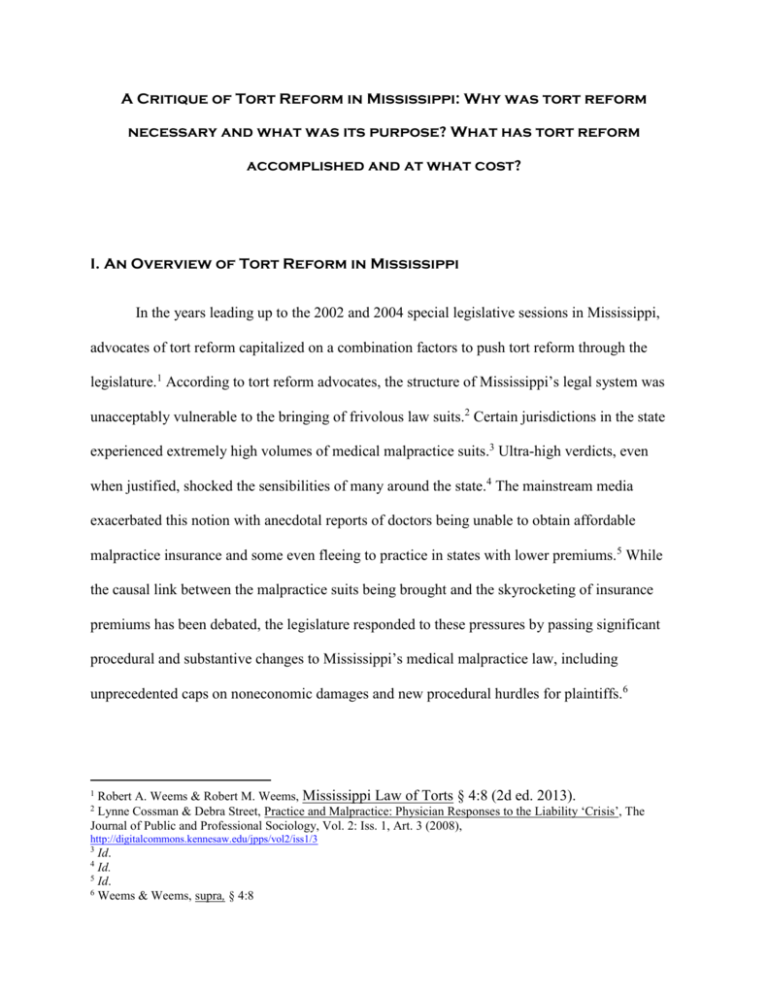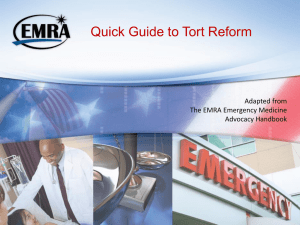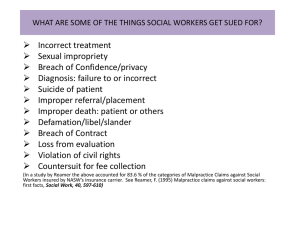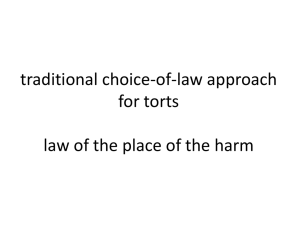A Critique of Tort Reform – Mitchell Thomas
advertisement

A Critique of Tort Reform in Mississippi: Why was tort reform necessary and what was its purpose? What has tort reform accomplished and at what cost? I. An Overview of Tort Reform in Mississippi In the years leading up to the 2002 and 2004 special legislative sessions in Mississippi, advocates of tort reform capitalized on a combination factors to push tort reform through the legislature.1 According to tort reform advocates, the structure of Mississippi’s legal system was unacceptably vulnerable to the bringing of frivolous law suits.2 Certain jurisdictions in the state experienced extremely high volumes of medical malpractice suits.3 Ultra-high verdicts, even when justified, shocked the sensibilities of many around the state.4 The mainstream media exacerbated this notion with anecdotal reports of doctors being unable to obtain affordable malpractice insurance and some even fleeing to practice in states with lower premiums.5 While the causal link between the malpractice suits being brought and the skyrocketing of insurance premiums has been debated, the legislature responded to these pressures by passing significant procedural and substantive changes to Mississippi’s medical malpractice law, including unprecedented caps on noneconomic damages and new procedural hurdles for plaintiffs.6 Robert A. Weems & Robert M. Weems, Mississippi Law of Torts § 4:8 (2d ed. 2013). Lynne Cossman & Debra Street, Practice and Malpractice: Physician Responses to the Liability ‘Crisis’, The Journal of Public and Professional Sociology, Vol. 2: Iss. 1, Art. 3 (2008), 1 2 http://digitalcommons.kennesaw.edu/jpps/vol2/iss1/3 3 Id. Id. 5 Id. 6 Weems & Weems, supra, § 4:8 4 A.) The Cap on Non-Economic Damages In 2002, the legislature enacted Miss. Code Ann. § 11-1-60 and established a $500,000 cap on noneconomic damages in medical malpractice cases.7 In 2004, the legislature amended the statute to add a $1 million cap on noneconomic damages in nonmedical malpractice cases.8 The 2004 version also deleted an exception for “disfigurement” and scheduled increases that had been passed in the 2002 version.9 The statute also is clear to point out the term “non-economic damages” does not include “punitive or exemplary damages.”10 Punitive or exemplary damages are governed under Miss. Code Ann. § 11-1-65 (West 2004).11 The pertinent portion of the statute provides: 2)(a) In any cause of action filed on or after September 1, 2004, for injury based on malpractice or breach of standard of care against a provider of health care, including institutions for the aged or infirm, in the event the trier of fact finds the defendant liable, they shall not award the plaintiff more than Five Hundred Thousand Dollars ($500,000.00) for noneconomic damages.12 The statute also provides the jury will not be informed of the cap, and it will be applied by a judge.13. In a 2007 decision, Estate of Klause, the Mississippi Supreme Court held the cap applies to plaintiffs in wrongful death actions under Miss. Code Ann. § 11-7-13 (West 2004).14 In Klaus, the court also suggests it would find the cap applicable in cases involving multiple defendants by instructing the term 7 Miss. Code Ann. § 11-1-60(2)(a)(West 2004) Miss. Code Ann. § 11-1-60(2)(c)(West 2004) 9 Weems & Weems, supra, § 4:9 10 Id. 11 Id. 12 Miss. Code Ann. § 11-1-60(2)(a)(2004) 13 Id. § 11-1-60(2)(c)(2004) 14 Estate of Klaus ex rel. Klaus v. Vicksburg Healthcare, LLC., 972 So. 2d 555, 558-59 (Miss. 2007). 8 “defendant” in the statute is to be read as “defendants”.15 In its analysis, the court based its holding, in part, on Mississippi Dept. Transp. v. Allred, where it had previously applied the Mississippi Tort Claims Act damages cap to a case involving multiple defendants. 16 The court, in Klaus, expressly stated the cap applies to, “plaintiff or plaintiffs.”17 Therefore, in multiple-plaintiff actions, plaintiffs could be faced with a cap significantly lower than $500,000.18 B.) Procedural Changes The legislature also enacted a requirement that plaintiffs give 60 days’ written notice of intention to bring the action, prior to filing suit against a health care provider for medical malpractice.19 The plaintiff must notify the defendant of the legal basis of the claim and the type of loss sustained, including with specificity the nature of the injuries suffered.20 Miss. Code Ann. § 11-1-58 requires, with some exceptions, the plaintiff’s attorney in medical malpractice cases to attach a certificate to the complaint to the effect that he has consulted with an expert prior to filing the lawsuit.21 The legislature also enacted Miss. Code Ann. § 11-1-62 to prevent medical professionals from being held strictly liable in pharmaceutical products liability case.22 The statute requires the plaintiff to plead facts which amount to negligence on the part of the medical provider; otherwise 15 Id. at 559. E.g., Weems & Weems, supra, § 4:9 Mississippi Dept. of Transp. v. Allred, 928 So. 2d 152, 154 (Miss. 2006). E.g., Weems & Weems, supra, 17 Estate of Klause, 972 So. 2d 555, 558-59 (Miss. 2007). 18 Weems & Weems, supra, § 4:9 19 Miss. Code Ann. § 15-1-36(15) (West 2004). E.g., Weems & Weems, supra, § 4:10 20 Id. § 15-1-36(15)(West 2002) 21 Id. § 11-1-58 (West 2002) 22 Id. § 11-1-62 (West 2002) 16 the provider cannot be sued.23 This will make it more difficult for Plaintiffs to find resident physicians to sue for purposes of defeating federal diversity jurisdiction.24 The legislature also established a two year statute of limitations for medical malpractice actions.25 The statute requires an action to be filed within two years of the date the act, omission, or neglect was discovered or should have been discovered with reasonable diligence.26 The time period begins to run when the patient discovers or should have discovered the injury, the cause of the injury, and the causal relationship between the injury and the medical provider’s conduct.27 The focus is on the time the patient discovers, or should have discovered through reasonable diligence, that he probably has an actionable injury.28 The statute establishes a period of repose of seven years after the alleged act, omission or neglect, after which no claim may be brought except for the following two exceptions: (1) where a foreign object introduced during a procedure is left inside the patient’s body, in which case the action accrues when the object is, or reasonably should have been, discovered, and (2) where the cause of action is fraudulently concealed, in which case the action accrues when the fraud is, or reasonably should have been, discovered.29 23 Id., E.g., Weems & Weems, supra, § 4:12 Weems & Weems, supra, § 4:12 25 Miss. Code Ann. § 15-1-36 (West 2002) 26 Id. 27 Id. 28 Weems & Weems, supra, § 4:13 29 Miss. Code Ann. § 15-1-36(2)(a)-(b)(West 2002) 24 II. Why was tort reform Necessary and what was its purpose? Mississippi, along with several other southern states, passed tort reform in response to a malpractice insurance crisis.30 There have been three national malpractice insurance crises since 1974, with interval periods of relative stability and moderate premium increases.31. The first crisis in the mid-1970’s involved a spike in premiums and the lack of availability of malpractice insurance coverage.32 With premiums rising as high as 500 percent in some states, some commercial insurers withdrew from the medical liability insurance coverage business.33 This led to tort reform being passed in several states.34 In the mid-1980’s, premiums increased across the country from 20-100 percent.35 This crisis was one of affordability in multiple lines of insurance in multiple jurisdictions.36 This crisis led to the passage of tort reform, including malpractice reform, in still other states.37 Finally, in the early 2000’s, a third national crisis happened.38 Premiums rose at least 15 percent for most physicians, and for specialists, increases were in the range of 20-33 percent.39 While the cause is debated by many, the legislature responded to increasing pressure from the health care industry, including insurers and physicians, to combat an increase in insurance premiums, to stop the perceived threat of doctors leaving the state, and to reign in a 30 Leonard J. Nelson, III, Michael A. Morrisey, & Meredith L. Kilgore, Medical Malpractice Reform in Three Southern States, 4 J. Health & Biomedical L. 69, (2008). 31 Id. at 71 32 Id. 33 Id. 34 Id. 35 Id. at 72 36 Id. 37 Id. 38 Id. 39 Id. system which had gained Mississippi notoriety as the “jackpot justice” capital of the nation.40 Contrary to this real or perceived threat, a Governmental Accountability Study in 2003 on the extent and implications of the malpractice crisis in five bellwether states reported anecdotal reports of insurance provider actions in response to malpractice problems such as withdrawing services or leaving the state were generally either not substantiated or had little widespread impact on access.41 Insurers and healthcare providers, however, point to increases in loss payouts, and decry a legal system rife with frivolous lawsuits and astronomical verdicts, along with the accompanying legal expense, as the cause of malpractice premium spikes.42 A.) Forces that brought about tort reform Neil Vidmar, the Russell M. Robinson, II, Professor of Law at Duke University Law School, and Leigh Anne Brown, a 2003 graduate of Mississippi College Law School, authored a 2002 piece published in the Mississippi College Law Review discussing the potential causes of the medical malpractice insurance crisis in Mississippi. According to the article, a Clarion Ledger piece in 2002 quotes one Gerald Wages, of Reciprocal of America, a liability insurance company, as testifying before congress, “[o]ur ability to continue writing insurance in Mississippi is seriously threatened at this point.”43 He is paraphrased as claiming, “the number of claims are rising higher than premiums collected, causing severe losses for the company and affecting the cost of insurance for hospitals and doctors.”44 In response to a question by a senator about a solution to the crisis, he said, “I think what it’s going to take is meaningful changes to 40 Cossman & Street, supra Cossman & Street, supra 42 Nelson, Morrisey & Kilgore, supra, at 72. 43 Neil Vidmar & Leigh Anne Brown, Tort Reform and the Medical Liability Insurance Crisis in Mississippi: Diagnosing the Disease and Prescribing a Remedy, 22 Miss. C. L. Rev. 10 (2002); See, e.g., Patrice Sawyer, Insurers: Claims Causing Losses, Clarion Ledger, at 1B (June 22, 2002). 44 Id. at 11 41 our civil justice system to get insurance companies to return to the state and start writing insurance.”45 Vidmar and Brown cite another 2002 article as saying, “doctors said they were told by many companies the skyrocketing premiums were the result of large jury verdicts being handed down against physicians in Mississippi.”46 Another article they cite reported, “the Medical Assurance Company of Mississippi, a doctor-owned insurance group, has notified doctors that it will raise its rates by forty-five percent due, in part, to the state’s legal climate, according to a letter sent to policy holders.”47 Critics of the pre-2002 tort system claimed large and undeserved jury awards had increased exponentially, resulting in a financial drain on the insurer reserves.48 Proponents of tort reform also alleged large awards had an immediate secondary effect of fostering frivolous litigation by plaintiff contingency fee lawyers hoping to hit a “jackpot” case, and also frightened defendants and insurers into unwarranted settlements out of fear of “runaway” juries.49 To digress for a moment, I once read a book called “Words That Work: It’s Not What You Say, It’s What People Hear” by a man named Frank Luntz.50 Mr. Luntz is a master wordsmith who has consulted with dozens of Fortune 500 companies and high-power politicians (remember the famous 1994 “Contract With America” Republicans rode into national legislative power)51. The terms “jackpot justice” and “runaway juries,” and variations thereof, became iconic symbols of the need for tort reform, evoking such disdain and disgust for even the noblest 45 Id. Id. See, e.g., Pamela Berry, Doctors Turning to Last Result, Clarion Ledger, at 10A. (July 21, 2002). 47 Id. See, e.g., Julie Goodman, Premiums Rise by 45%: Insurance Group's Hike Comes As Doctors Seek Relief, Clarion Ledger, 1A (September 22, 2002). 48 Vidmar & Brown, supra at 12. 49 Id. 50 Frank Luntz, Words That Work: It’s Not What You Say, It’s What People Hear, (2007). 51 Id. 46 of plaintiff’s attorneys that I have begun to wonder whether the masterful Mr. Luntz himself was involved in their creation (which to my knowledge he was not). Speaking of Republicans riding into power, the issue of tort reform served as a powerful catalyst in Mississippi politics, and in-turn perhaps, Mississippi politics served as a powerful catalyst for tort reform in the 2000-2004 years. Longtime nationally syndicated political columnists and Mississippi State University Director of Public Affairs Sid Salter (and fellow Philadelphia, Mississippi native, I might add) wrote a 2003 article entitled, “Tort Reform Drives Political War”.52 Salter writes, “[w]hile Democratic Gov. Ronnie Musgrove and Republican challenger Haley Barbour still get marquee billing, the gubernatorial campaign – and particularly the gubernatorial campaign contributor’s lists – are driven by the single issue of tort reform.”53 Salter discusses a Forbes magazine, July, [2003] article entitled “Buying Justice” which outlines that Mississippi had been a political battleground between trial lawyers, Big Labor and Democrats on one side and Big Business, insurance companies and Republicans on the other.54 The article chronicled the fact that trial lawyers have historically been the campaign contribution “sugar daddies” of the very judges before whom they will argue their cases, and in those years preceding tort reform, the business community on its own and through groups like the U.S. Chamber of Commerce responded with hardball politics to combat the trial lawyers’ influence.55 Salter quotes then-State Medical Association president Dr. John Cook as accusing U.S. Chamber opponents of trying to “excoriate the Chamber for failing to disclose the source of the money it spent on the 2000 state judicial elections, while consistently refusing to mention that the trial 52 Sid Salter, Tort Reform Drives Political War, (July 9, 2003) available at http://www.freerepublic.com/focus/fnews/943033/posts 53 Id. 54 Id. 55 Id. lawyers political action committee (ICEPAC) did exactly the same thing with huge sums of money it collected from out-of-state plaintiff attorneys who want to maintain the status quo in Mississippi’s strike-it-rich court system.”56 Salter leaves us with an ominous-for-trial lawyers foreshadowing: “As the gubernatorial campaign unfolds, tort reform will gain intensity as an issue. Barbour is a clear proponent of tort reform. Musgrove – the former darling of the trial lawyers – angered many of them when relatively mild tort reforms were adopted in 2002. Stay tuned.”57 All of us who did stay tuned know how the story plays out – the now-beloved-by-many Republican Haley Barbour, went on to crush Democrat Ronnie Musgrove in the gubernatorial race, garnering 52.59% of the vote compared to Musgrove’s 45.81%.58 The Honorable Governor Musgrove was later defeated by Republican Roger Wicker in a 2008 special election for one of Mississippi’s U.S. Senate seats, and is currently Of Counsel with the Jackson, Mississippi firm of Copeland, Cook, Taylor & Bush.59 The Honorable Governor Barbour was reelected to the governorship in 200760, finishing his last constitutionally-allowed term as governor in 2012. In 2010, the Politico news site dubbed Barbour “the most powerful Republican in American politics,”61 and there was speculation he would run for the 2012 Republican presidential nomination,62 although he decided against it. Governor Barbour subsequently joined national firm Butler, Snow, O’Mara, Stevens and Cannada, with its Mississippi base in Jackson,63 and 56 Id. Id. 58 http://www.sos.state.ms.us/elections/2003GeneralReCap/Certified/01Governor.pdf (2003). 59 Attorney profile available at http://copelandcook.com/musgrove-ronnie/ 60 http://www.sos.state.ms.us/elections/2007/Statewide%20Results/Governor.pdf 61 Jim Vandehi, Andy Barr & Kenneth P. Vogel, The Most Power Republican in Politics, Politico, (2010) available at http://www.politico.com/news/stories/0810/41236.html 62 Chris Cillizza, Barbour to Iowa, The Washington Post (2009) available at http://voices.washingtonpost.com/thefix/eye-on-2012/barbour-to-iowa-1.html 63 http://www.butlersnow.com/Press_Room/News/Barbour,_Hurst_Join_Butler_Snow/ 57 rejoined the Washington, D.C. based BGR Group lobbying firm he co-founded.64 As for the rest of Mississippi state politics? The Republican Party has won every statewide65 elected office since the 2003 gubernatorial race, with the exception of Democratic Secretary of State Eric Clark in 200366 and Democratic Attorney General Jim Hood. Republican Delbert Hosemann would replace Clark as Secretary of State in 200767 (Hosemann was unopposed in 2011)68 , leaving Jim Hood as the lone statewide Democratic official. (Hood was reelected in 200769 and 201170). The above-cited article by Sid Salter also provides some insight into a litigation climate which, due in part to attorney greed, shocked many across the country. Salter quotes Prof. Lester Brickman of the Cardozo School of Law in New York as saying, “[t]he toughest battles are playing out in Mississippi, where litigation over asbestos and the faulty drug fen-phen are huge sources of revenue. In one case in 2001 a jury in Holmes County Court awarded $150 million to six plaintiffs who never became ill from asbestos exposure – they simply feared they would some day.[sic] In a three-county district presided over by trial court Judge Lamar Pickard, lawyers have filed some 4,000 separate fen-phen cases. Typically these lawyers gather plaintiffs by distributing circulars listing a hotline number and hiring legmen to work the smaller rural town in search of more “victims” To[sic] settle such complaints nationwide, Wyeth has dished out $12.8 billion thus far, but it is far from done. The plaintiff lawyers have landed up to $3.8 64 Rachel Leven, Haley Barbour to Return to Lobby Firm, (December 2011) available at http://thehill.com/businessa-lobbying/200955-haley-barbour-to-rejoin-lobby-firm 65 *For the purposes of this discussion, “statewide” refers only to the offices of Governor, Lt. Governor, Secretary of State, Attorney General, State Treasurer, State Auditor, Commissioner of Insurance, and Commissioner of Agriculture and Commerce – those offices being elected by the entire state electorate, as opposed to regional or district based electorates. 66 http://www.sos.state.ms.us/elections/2003GeneralReCap/Certified/03Secretary%20of%20State.pdf 67 http://www.sos.state.ms.us/elections/2007/Statewide%20Results/Secretary%20of%20State.pdf 68 http://www.sos.ms.gov/links/elections/results/statewide/Sec%20of%20State_Statewide%20%20General%20Election%202011%20Results.pdf 69 http://www.sos.state.ms.us/elections/2007/Statewide%20Results/Attorney%20General.pdf 70 http://www.sos.ms.gov/links/elections/results/statewide/Atty%20General_Statewide%20%20General%20Election%202011%20Results.pdf billion, assuming a traditional 30 percent lawyer’s fee.”71 While some scholars may have accurately characterized Mississippi at the time as a “Mecca for tort suits,”72 Vidmar and Brown raise a legitimate question about whether, even if the general claim about Mississippi’s tort system is true, it applies to medical malpractice cases.73 According to Vidmar and Brown, in most medical malpractice cases in state courts, both plaintiffs and defendants are citizens of the state, often residing in the same community, as opposed to the non-medical malpractice torts, a la fen-phen, where (based upon at least anecdotal evidence, and Vidmar and Brown do not take a position on the validity of this claim) a substantial number of claims involving multiple plaintiffs against multiple defendants headquartered in other states, such as drug companies, were filed.74 In any event, medical malpractice cases were quite a different matter than the mass tort lawsuits brought against large out-of-state corporations75 that made so many millions and billions of dollars for plaintiff’s attorneys as well as defense attorneys (they didn’t defend all of those lawsuits for free now did they?). Without a doubt, the sticker shock most Mississippians and Mississippi politicians felt in response to these mega-verdicts created a tidal wave of public support for tort reform that, with a little help from the physician and insurance lobbies, swallowed up the field of medical malpractice litigation and, in 2004, came crashing down in the form of some of the most sweeping tort reform legislation in the country, leaving detractors of the effort cowering in its wake. 71 Salter, supra Vidmar & Brown, supra at 12-13; See, e.g., Mark Ballard, Mississippi becomes a Mecca for tort suits, The National Law Journal at A1, (April 30, 2001). 73 Vidmar & Brown, supra at 13 74 Id. 75 Id. 72 B.) Theories opposing tort reform Critics of tort reform claim high malpractice premiums are caused by something other than an influx in medical malpractice lawsuits. Consumer activists and trial lawyers, as well as some legal scholars, assign blame for these insurance crises to the natural cycle of the market coupled with investment practices of insurance companies.76 Those holding this point of view argue, as insurance companies’ returns on investments fell with market values, premiums are increased to compensate for lost revenue.77 Professor Tom Baker, a preeminent scholar in insurance law, and the William Maul Measey Professor of Law and Health Sciences at the University of Pennsylvania Law School, has contended the malpractice crises are caused by the underwriting practice, attributing malpractice premium volatility to a phenomenon in which loss estimates are periodically underestimated until actual loss experience results in firms overestimating predicted losses and increasing reserves, thereby causing a spike in premiums.78 Professor Baker points out that medical inflation is the most important factor influencing the rate of growth in loss payouts in medical malpractice cases.79 The time of delay in learning what actual losses occur further exacerbates this problem.80 In line with what Prof. Baker has argued, the U.S. General Accounting Office (U.S.GAO) has reported that insurance rate setting uses actuarial techniques to set rates, to generate funds to cover: (1) losses occurring during the period, (2) the administrative costs of running the 76 Nelson, Morrisey & Kilgore, supra, at 72. Id. 78 Id. at 73, E.g., Tom Baker, The Medical Malpractice Myth, 51-58 (2005). 79 Id. 80 Id. 77 company, and (3) an amount for unknown contingencies, which may become a profit if not used.81 The U.S. GAO has described the malpractice insurance cycle as follows: A variety of factors combined to explain the malpractice insurance cycle that produced several years of relatively stable premium rates in the 1990’s followed by the severe premium rate increases of the past few years. To begin with, insurer losses anticipated in the late 1980’s did not materialize as projected, so insurers went into the 1990’s with reserves and premium rates that proved to be higher than the actual losses they would experience. At the same time, insurers began a decade of high investment returns. This emerging profitability encouraged insurer to expand their market share, as both the downward adjustment of loss reserves and high investment returns increased insurers’ income. As a result, insurers were generally able to keep premium rates flat or even reduce them, although the medical malpractice market as a whole continued to experience modestly increasing underlying losses throughout the decade. Finally, by the mid-to late 1990’s, as excess reserves were exhausted and investment income fell below expectations, insurers’ profitability declined.82 This set the stage for the malpractice insurance premium crisis of the 2000’s.83 Because of the over-investment, some insurers became insolvent and others dropped their malpractice lines of insurance.84 Those who remained were able to demand large rate increases.85 81 U.S. General Accounting Office, Medical Malpractice: No Agreement on the Problems or Solutions, 66-72, (1986); See, e.g., Barry R. Furrow, Thomas L. Greaney, Sandra H. Johnson, Timothy S. Jost, & Robert L. Schwartz, Health Law Cases, Materials and Problems 506 (7th ed. 2013) 82 U.S. General Accounting Office, Medical Malpractice Insurance: Multiple Factors Have Contributed to Increased Premium Rates, (2003); See, e.g., Furrow, Greaney, Johnson, Jost & Shwartz, supra at 511. 83 Furrow, Greaney, Johnson, Jost & Shwartz, supra at 511 84 Id. 85 Id. Prof. Baker’s assertion that malpractice insurance crises are influenced by the underwriting cycle echoes a 2002 study’s findings. According to the study, the medical malpractice insurance market is prone to cycles of underpricing, lost revenue by insurers, and catchup.86 Doctors and hospitals, having been placated by the underpricing of premiums, see these “sudden” price increases during periods of catchup which are actually deferred costs passed on when premiums no longer cover payments plus profit.87 Once premiums reach actuarially sound levels, profits rise; new insurers enter the market with lower rates, competitive pressures return, and the cycle starts over again.88 The cyclical nature of interest rates also plays a determinative role in insurer’s pricing.89 The insurance industry engages in cash-flow underwriting, whereby insurers invest the premiums they collect in the bond market and the stock market, and during periods of high returns and high interest rates, insurance companies accept more risks to acquire premium and loss reserves they can invest.90 The premiums charged to healthcare providers do not relate to payouts to malpractice plaintiffs, but rather are a reflection of gains and losses on investments, rising and falling with the economy.91 Perhaps the most accurate and enlightening statement uncovered in the writing of this paper was one made by Vidmar and Brown in the Mississippi College Law Review article discussed above. They observe it is indeed possible that all of these theories concerning the cause of the malpractice insurance crisis in Mississippi could be correct: policy underpricing coupled with actuarial miscalculation of indemnities to be paid, medical inflation, the tort system, and the 86 Furrow, Greaney, Johnson, Jost & Shwartz, supra at 512-13; see generally, Mimi Marchev, The Medical Malpractice Insurance Crisis: Opportunity for State Action, National Academy for Health Policy (July 2002). 87 Id. 88 Id. 89 Id. 90 Id. 91 Id. insurance business cycle (including the underwriting and investment processes discussed above).92 Even more enlightening perhaps, is their observation that the public debate in Mississippi, as reflected in newspaper coverage, was focused entirely on the tort system while only giving minimal attention or entirely dismissing alternative theories about the malpractice insurance crisis as false.93 III. The cost of tort reform A.) Projected Incidences of Malpractice and the Expansion of Liability Tort reform, as has been enacted, seems to focus exclusively on protecting healthcare providers and insurance carriers by reducing their liability, while mostly ignoring the harmful effects of malpractice on patients, which as reflected by the studies below, is a wide-spread and regularly occurring problem across the country. According to the Institute of Medicine of the National Academies, one third of hospitalized patients are harmed during their hospitalization, less than half of patients receive clear information of the benefits and trade-offs of treatments for their conditions, and almost half of patients are not satisfied with their level of control in medical decision making.94 As many as 98,000 patients die from medical errors each year.95 A Harvard 92 Vidmar & Brown, supra, at 12. Id. 94 Institute of Medicine Infographic, Best Care at Lower Cost, available at http://www.iom.edu/Reports/2012/BestCare-at-Lower-Cost-The-Path-to-Continuously-Learning-Health-Care-in-America/Infographic.aspx. The Institute has provided an extensive listing of the sources they used to compile this information available at http://www.iom.edu/Reports/2012/Best-Care-at-Lower-Cost-The-Path-to-Continuously-Learning-Health-Care-inAmerica/~/media/Files/Report%20Files/2012/Best-Care/infographic_references.pdf 95 L.T. Kohn, J.M. Corrigan, & M.S. Donaldson, eds., To Err Is Human: Building a Safer Health System, A Report of the Committee on Quality of Health Care in America, Institute of Medicine, National Academy Press, (2000). 93 Medical Practice study reflects as many as 4 percent of hospitalized patients suffer an adverse medical event severe enough to result in disability or death.96 While most insurance carriers and healthcare providers have been proponents of the notion that expanded malpractice liability is the result of increased payouts and runaway jury verdicts, the industrialization of the health care industry has contributed to an expansion of liability as well.97 Institutions and groups deliver health care to patients, and hospitals are subject to stricter scrutiny.98 As the healthcare industry has grown and become more specialized, the field of malpractice has followed suit.99 While the premium spikes are historically considered to be the result of perceived litigation risks to physicians, the expansion of liability to industries and companies has also contributed to the cost of providing insurance.100 Another effect of industrial advancements has been brought about by cost containment mechanisms built into the organizational structure of these new healthcare entities.101 Managed care systems prevent physicians from passing increased malpractice insurance premium costs on to patients or insurers, thereby decreasing revenue for the physicians.102 To compensate, doctors see more patients per day, spending less time with each patient.103 While this does not necessarily translate into increased incidences of negligence by doctors, it does create a more litigious environment 96 Harvard Medical Practice Study, Patients, Doctors, and Lawyers: Medical Injury, Malpractice litigation, and Patient Compensation in New York, Exec. Summ. 3-4(1990); See, e.g., Furrow, Greaney, Johnson, Jost & Shwartz, supra, at 506 (7th ed. 2013). 97 Furrow, Greaney, Johnson, Jost & Shwartz, supra, at 507. 98 Id. 99 Id. 100 Id. 101 Id. 102 Id. 103 Id. for a patient who has been injured. Disgruntled patients are more likely to sue than those who are able to voice their concerns and have them acknowledged by the offending doctor.104 B.) The Effect of Tort Reform on Malpractice Lawsuits Mark A. Behrens, Esq., one of Washington, D.C.’s top lawyers, specializing in defense litigation, civil justice reform and counseling in the prevention of liability exposure, is the cochair of international firm Shook, Hardy & Bacon’s Washington-based Public Policy Group.105 Mr. Behrens authored a 2011 study comparing lawsuits against doctors in all specialties before and after tort reforms were adopted in 2003.106 The study examined physicians covered by the largest medical liability insurer in the state, the Medical Assurance Company of Mississippi (MACM), which insures more than 75% of Mississippi’s physicians.107 According to a discussion of the study by Alicia Gallegos, a writer for American Medical News, published by the American Medical Association, from 2000 to 2004, an average of 318 lawsuits were filed each year against doctors covered by MACM.108 Between the years of 2005 and 2009, only 140 such lawsuits were filed.109 For obstetrician-gynecologists in particular, an average of 44 suits were filed each year from 2000 to 2004, and between 2005 and 2009, this figure had dropped to 15.110 104 Id. Attorney biography available at http://www.shb.com/attorney_detail.aspx?id=13 (Mr. Behrens is also a partner at Shook, Hardy & Bacon, a member of the ALI, and has taught law at The American University’s Washington College of Law and Pepperdine University School of Law in California). 106 E.g., Alicia Gallegos, Mississippi Tort Reforms Lead to Reduction in Lawsuits, American Medical News (August 22, 2011), available at http://www.amednews.com/article/20110822/profession/308229941/6/; Mark A. Behrens, Medical Liability Reform: A Case Study of Mississippi, Obstetrics & Gynecology, 335-339, (August 2011). 107 Id. 108 Id. 109 Id. 110 Id. 105 The study also observes insurance premiums dropped considerably after tort reform efforts.111 From 2000 to 2004, premiums for all specialties escalated by 98%, with no change in premiums occurring in 2005.112 Between 2006 and 2010, premiums reportedly decreased from 520% each year.113 Mr. Behrens argues this data proves how significant tort reforms in Mississippi have been. (Mr. Behrens was also co-counsel for the American Tort Reform Association).114 According to Mr. Behrens, and contrary to the views of critics like Prof. Tom Baker discussed above, “[c]ommon sense suggested that [award limits] would result in lower payments by insurers and that free market forces would ensure that those savings would be passed on to physicians. The reductions in Mississippi as a result of tort reform, both in terms of the number of lawsuits filed and the premiums paid by physicians, were quite dramatic.”115 According to Behrens, claims by Plaintiff’s attorneys that limits on damages awards do not improve the medical liability climate are intuitively baseless, and this study provides “empirical data to objectively answer these charges for the benefit of policymakers and courts.”116 Behrens’ study has not gone un-criticized, however. Mary H. Graffam, Director of Research for the American Association for Justice (AAJ) in Washington, D.C., has written a piece for the AAJ rebuking Behren’s data as misleading.117 Notably left out of Behren’s study, Graffam says, was the fact that an analysis of MACM’s rates shows the company’s rates for Mississippi Obstetrician/Gynecologists were stable between 1998 and 2001, a period prior to tort 111 Id. Id. 113 Id. 114 Id. 115 Gallegos, supra 116 Id. 117 Mary H. Graffam, Tort Reform Lobbyist Publishes Disingenuous Assessment of Medical Malpractice Caps, (July 2011) available at http://www.fightingforjustice.org/content/tort-reform-lobbyist-publishes-disingenuousassessment-medical-malpractice-caps 112 reform legislation when the cap on damages was not in place.118 Between 2002 and 2003, despite passage of tort reform legislation setting the damages caps, rates shot up 45 percent.119 In 2004, MACM raised rates an additional 20 percent.120 In 2006 Obstetrician/Gynecologists covered by MACM saw their rates decrease by 5 percent.121 At this point, the insurance “crisis” producing increased rates for doctors nation-wide was easing and premiums started to drop across the country.122 According to Graff, Behrens’ assertion that Mississippi’s caps reduced premiums was contradicted by his colleague at the American Tort Reform Association, Mr. Sherman Joyce, who she quotes as being “on record” saying, “[w]e wouldn’t tell you or anyone that the reason to pass tort reform would be to reduce insurance rates.”123 Although it does not necessarily negate her assertion that Mr. Joyce’s statement contradicts Mr. Behrens, it is worth noting (to preserve the objective position and tone of this paper) that Mr. Behrens’ assertions were made in a study published in 2011, while her cite to Mr. Joyce’s statement refers to a 1999 article.124 C.) The effect of tort reform on plantiffs Proponents of tort reform have focused almost solely on the search for relief from, what many authorities suggest are market-driven, premium policies of malpractice insurance providers.125 Lucinda M. Finley, the Frank Raichle Professor of Law at SUNY Buffalo Law School126 raises important issues about those who were left out of the public debate over tort 118 Id. Id. 120 Id. 121 Id. 122 Id. (citing to: Medical Liability Monitor, various rate survey editions) 123 Id. (citing to: Liability Week (July 1999) 124 Id. 125 Lucinda M. Finley, Hidden Victims of Tort Reform: Women, Children, and the Elderly, The 2004 Randolph W. Thrower Symposium: The Future of Tort Reform: Reforming the Remedy, Re-Balancing the Scales, 53 Emory L.J. 1263 at 1265 (2004). 126 Profile available at http://www.law.buffalo.edu/faculty/facultyDirectory/FinleyLucindaM.html 119 reform.127 Although her 2004 paper addresses the issue from the standpoint of prospective national tort reform, the concerns she discusses are directly applicable in Mississippi, where sweeping tort reform legislation has already occurred. Damages caps, she argues, are not likely to alter the hard market/soft market insurance cycles affecting premium rates and insurance availability (discussed above), but they do make it less likely certain types of injuries will be redressed through the courts.128 The reasons being, claims with low economic loss recovery value, but high noneconomic loss are no longer worth pursuing.129 For example, a person who earns low or no wages, like the poor or the elderly, does not stand to recover as much for lost wages as a young professional injured in his prime, and, if their medical expenses are low, although they may have suffered a life altering disability due to egregious conduct by a physician or healthcare provider, their pain and suffering damages are capped at $500,000.00 in Mississippi. If the amount of time and money an attorney has to invest to recover this money is too great in proportion to the percentage he stands to recover, then there is a decreased financial incentive for him to take this case, forcing them to take on lower quality legal representation or leaving the person without any recovery. Finley says these caps have a significant adverse impact on women and the elderly, and on cases involving the ultimate injury of death, especially when a child dies as a result of medical malpractice.130 Finley conducted research comparing empirical evidence from several states on how juries in medical malpractice and other tort suits allocate their damage awards between economic loss damages and noneconomic loss damages and compared those cases in which men were the 127 Finley, supra at 1265. Id. 129 Id. 130 Id. 128 victims to cases where women were the victims.131 Her findings demonstrated, while overall men tended to recover greater total damage awards, juries consistently awarded higher noneconomic damages to female victims.132 Assuming these findings can be extrapolated to Mississippi jurisdictions, the noneconomic damages cap has a disproportionate effect on women as compared to men by reducing the field of damages where jurors, for reasons to be discussed below, apportioned a large proportion of women’s recovery.133 Because of this disproportionate effect, Finley argues, a cap on noneconomic damages (like Mississippi’s) constitutes a form of discrimination against and contributes to decreased access to justice for women. Without going further, one might counter that this does not constitute discrimination against women because it merely corrects the propensity of a jury to award higher noneconomic damages to women as opposed to men; however, Finley goes on to explain why juries tend to allocate a larger proportion of women’s recovery to the field noneconomic damages. Certain injuries happening primarily or exclusively to women are compensated predominantly through noneconomic loss damages.134 These injuries include sexual or reproductive harm, pregnancy loss and sexual assault injuries, and they impact women through impaired fertility or sexual functioning, miscarriage, incontinence, trauma associated with sexual relationships, and scarring or disfigurement in sensitive, intimate areas of the body.135136 These injuries and their impacts do not primarily affect the wage earning capacity of a woman, but they do have a devastating effect 131 Id. Id. at 1266 133 See generally, Id. 134 Id. 135 Id. 136 Along these lines, as discussed at the onset of this paper, in the 2002 tort reform legislation passed in Mississippi, the state legislature included an exception to the noneconomic damages cap for “disfigurement”, that would have alleviated some of the harshness of the cap on persons suffering this type of injury, as well as scheduled increases in the caps presumably to adjust them for inflation; however, in the more sweeping 2004 legislation, the legislature deleted the exception for disfigurement as well as the scheduled increases in the cap. See, Weems & Weems, supra, § 4:9 132 in the form of emotional suffering and lost self-esteem, through an impaired sense of self-worth and ability to function as a whole person, as well as the inability or decreased ability to maintain relationships.137 Finley points out that, although these aspects of life hold little economic worth in the market, they are priceless pieces of life and market-based economic loss damages are inadequate to compensate for them.138 Noneconomic damages are the tort system’s way of signaling what our society values and deems worth protecting, beyond what can be measured through actuarial calculations based on a person’s income and age.139 One set of circumstances Finley points to evidencing the injustice of the cap on noneconomic damages are those where children die as a result of obstetrical or other medical malpractice.140 In these situations, parents of these children will have more difficulty finding lawyers to take their case because the majority of the compensation will be in noneconomic damages.141 U.S. District Judge Carlton Reeves, Southern District Mississippi, summarized this succinctly when he reluctantly applied the Mississippi damage cap: All grief is not equal. All pain cannot be reduced to a one-size-fits-all sum. One cannot imagine what it is like to know that the doctor right in front of you, the one who is refusing to insert a chest tube into your body even as nurses beg her to provide that treatment, is causing you to die and killing your unborn baby as you are helpless to stop her. In Mississippi, though, one’s suffering at the hands of a health care provider is worth no more than half a million dollars, no matter how egregious, and no matter if your suffering leads to your death, your unborn child’s death, and leaves your children orphans. This is offensive.142 137 Id. Id. 139 Id. at 1279 140 Id. at 1280 141 Id. 142 Clemons v. United States of America, WL 5364737 (not reported in F.Supp.2d)(S.D. Miss. 2012). 138 AFTERWORD AND CONCLUSION Up and until this point, I have done my best to remain objective and present each position and their supporting authorities clearly and as I found them. Now, having presented my research, I will give you my personal thoughts. It is difficult to avoid an air of hypocrisy when presenting an attorney’s perspective (*I should tell you though, I’m not quite yet an attorney) on the issue of tort reform, albeit that does not deter most from jumping right in. Throughout my three years in law school at the University of Mississippi, I have had the opportunity to listen to and read about tales from many lawyers regarding the so-called “golden years” of Mississippi tort litigation. One attorney-friend recounted how he made $1,200 per week clerking for a defense firm his first summer in law school. By contrast, I made $500 per week my first summer. Another attorney regaled me with stories of $50 million-a-year profits, as well as owning his own private jet and ski-resort, and these are just a couple of my own limited encounters. According to a 2002 National Law Review article, nine of the nation’s 50 winningest law firms in 2001 were in the state of Mississippi.143 Indeed, then-Senate Majority Leader Trent Lott of Mississippi brought this article up, as reported by none other than Sid Salter in the Clarion Ledger, in U.S. Senate debate while arguing there was a medical malpractice crisis affecting the country, citing anecdotal evidence of hundreds of doctors leaving the state or retiring because of the inability to get affordable malpractice coverage.144 Senator Lott had Salter’s article printed into the record.145 According to Salter’s 143 Sid Salter, Top 50 Law Firm List Shows 9 in Mississippi, Clarion Ledger (July 28, 2002). Congressional Record Vol. 148-Part 11: Proceedings and Debates of the 107th Congress Second Session at 15303 (July 30, 2002) available at 144 report of the National Law Journal article, these nine firms included such well known Mississippi firms as: Blackmon and Blackmon at number 12 with six verdicts totaling $171 million, with $100 million coming from a single verdict against Janssen Pharmaceutical, Inc.; Porter and Malouf out of Greenwood scored $150 million off two verdicts; and former Governor Bill Allain made the list with a $77.5 million against St. Paul Fire Insurance, just to name a few.146 It should be noted here that none of these were medical malpractice cases. I have often lamented, along with some of my other fellow law students, about how, “if we had only been born twenty years ago,” perhaps we could have joined in on the bonanza. However, perhaps there is a “silver lining” as far as attorneys go. Phillip W. Thomas, on his online blog, described a scene back in the early 2000’s when he defended a retailer in the silica litigation, saying he showed up to a deposition at a hotel conference room and there were approximately thirty defense lawyers, who did mostly nothing during the deposition, one plaintiff lawyer, and a stunning amount of time being billed.147 Since then, the number of lawyers needed to defend cases has dropped considerably, along with the size of the verdicts plaintiff’s lawyers were taking in, and in turn there has been a great contraction in the legal job market. I know this is not sounding much like a silver lining yet. My point is: those who remain are the resilient and the hungry (no hungry-lawyer-pun intended). It is not as much about the http://books.google.com/books?id=nU4mhnvgdDgC&pg=PA15303&lpg=PA15303&dq=national+law+journal+50+w inningest+2002+salter&source=bl&ots=42Xxtq3XXR&sig=Rb3aFe66lACmJI6jbEQDF8vqlg&hl=en&sa=X&ei=gpVZU5uYJ4Py8QH3kIDQCw&ved=0CCcQ6AEwAA#v=onepage&q=national%20law%20journ al%2050%20winningest%202002%20salter&f=false 145 Id. 146 Id. 147 Phillip W. Thomas, MS Litigation Review, (March 5, 2014) available at http://www.mslitigationreview.com/2014/03/articles/general-1/how-much-is-mississippi-legal-industry-revenuedown-since-the-peak/ money anymore, although it will always, to a certain extent, be about the money. Now that it is more difficult to make a million dollars as an attorney, at least some of those who were just in it because of greed, or those of my generation who would have just been in it because of greed, are not in the game, or at least not playing the game the same way. Perhaps this noble profession can rediscover itself as what Alexis de Tocqueville called, “the most powerful existing security against the excesses of democracy.”148 Perhaps it is not the profession that needs to rediscover itself, but the general public which needs to rediscover that lawyers are in fact the most powerful existing security they have against the excesses of democracy. After all, the excesses of democracy are what forced the damages caps down the throats of medical malpractice victims. Perhaps the profession itself fell victim to its own excesses, and the populace, through the fog of high-glass law firms, Mercedes, and hundreds-of-millions of dollar verdicts, forgot people actually do need lawyers. They need us when their freedom is threatened, when their constitutional rights are being trampled on, when they are about to lose everything, when they have lost everything, and when they have everything to gain. After all, no one ever complains about doctors making too much money.149 Data released by Medicare and reported on in early April 2014 showed, out of $77 billion in Medicare payments for the year of 2012, Medicare paid $12 billion for 214 million office and outpatient visits, most between 15 and 25 minutes long, an 148 Alexis de Tocqueville, Democracy in America, (1835) available at http://xroads.virginia.edu/~Hyper/DETOC/1_ch16.htm 149 Apparently the government even continues to pay them after they are arrested or sanctioned. See Charles Ornstein & Tracy Weber, Even After Doctors Are Sanctioned or Arrested, Medicare Keeps Paying, Pacific Standard Magazine Online (April 24, 2014) available at http://www.psmag.com/navigation/health-and-behavior/evendoctors-sanctioned-arrested-medicare-keeps-paying-79747/ (According to the article, dozens of physicians who received millions of dollars in payments from Medicaid in 2012 had already been kicked out of Medicaid, charged with fraud, or settled claims of overbilling Medicare itself; including one doctor who received $862,000 despite the fact that he was arrested in August 2011.) average of $57 dollars a visit.150 Apparently, much of Medicare spending is concentrated on about two percent of doctors who account for about $15 billion in Medicare payments, roughly a quarter of the total.151 Where is the public outcry? Where is the political movement for reforming healthcare cost and medical billing? I can hear them now: “Oh they deserve that money, and think about how long they went to school. Doctors help people. We couldn’t live without them.” I suppose my hypocrisy knows no bounds. I don’t want to point any fingers at doctors, however. (God forbid, I may get sick tomorrow!) The blame for the malpractice insurance crisis certainly didn’t belong to the physicians, and they only lobbied for tort reform because insurers were raising their malpractice premiums so high they were at risk of losing their livelihoods. Regardless of the role Mississippi’s tort system played in influencing medical malpractice insurance premiums, a much broader, more sinister issue is raised in my mind. Medical Assurance Company of Mississippi (MACM) covers at least 75% of physicians in the state.152 As cited above, MACM sent a letter to physicians in 2002 notifying them they were going to raise their rates by fort-five percent due in part to Mississippi’s legal climate.153 Vidmar and Brown added emphasis to the words in part to point out to the reader that even MACM tacitly admits there was something other than the legal climate affecting malpractice insurance rates.154 As has been discussed thoroughly, many legal and insurance scholars, and even the United States General Accounting Office, have provided empirical data to show rates were primarily affected by forces other than malpractice suits and 150 Reed Abelson & Sarah Cohen, Sliver of Medicare Doctors Get Big Share of Payouts, The New York Times (April 9, 2014) available at http://www.nytimes.com/2014/04/09/business/sliver-of-medicare-doctors-get-big-share-ofpayouts.html?_r=0 151 Id. 152 Gallegos, supra; See, Behrens, supra 153 Julie Goodman, Premiums Rise by 45%: Insurance Group's Hike Comes As Doctors Seek Relief, Clarion Ledger, 1A (September 22, 2002). 154 Vidmar & Brown, supra at 10. payouts. The way it played out in 2002-2004 was simple and disturbing: insurers, who had lost money as a result of competition among other carriers, over-investment, medical inflation, and actuarial miscalculation, flexed their muscle by extorting physicians155 and in-so-many words telling the legislature to either cap medical malpractice damages or they simply wouldn’t write insurance156 (at least any insurance doctors could afford.) Like the days of old when Carnegie and Rockefeller monopolized their industries, vanquished their foes and set their prices, the soulless (wait, aren’t corporations people too?) Mississippi insurance companies enjoy a lack of competition, an unlimited demand for their product, and an unwillingness of government to reign in their robber-baron piracy. Is there change on the horizon? I do not pretend to be clairvoyant, but some jurisdictions are split regarding the constitutionality of a cap on noneconomic damages. In 2013, the federal 5th Circuit Court of Appeals upheld Mississippi’s noneconomic damages cap in the face of constitutional challenge.157 Learmonth argued § 11-1-60(2)(b) invaded the jury’s exclusive sphere by revising downward any noneconomic damages finding in excess of $1 million.158 The court admits, at first blush, the statute’s limit on the jury’s act of “awarding” noneconomic damages might appear to interfere with the jury’s fact finding procedure.159 However, the court rationalizes by saying it does not “believe” the legislature used the term “award” in the technical or legal sense of finding a damages amount.160 (Plain-language-be-damned, apparently.) Because 155 See Pamela Berry, Doctors Turning to Last Result, Clarion Ledger, at 10A. (July 21, 2002). “doctors said they were told by many companies that the skyrocketing premiums were the result of large jury verdicts being handed down against physicians in Mississippi.” 156 See Patrice Sawyer, Insurers: Claims Causing Losses, Clarion Ledger, at 1B (June 22, 2002). “I think what it’s going to take is meaningful changes to our civil justice system to get insurance companies to return to the state and start writing insurance.” 157 Learmonth v. Sears, Roebuck and Co., 710 F. 3d 249 (5th Cir. 2013) 158 Id. at 259. 159 Id. 160 Id. at 260 a jury who is not aware of the $1 million limit cannot apply it when determining damages, the court explains, it does not invade the jury’s fact finding process.161 Because it is the judge who reduces any award to comply with the cap, the statute is in comport with the judge’s role of applying the law to the jury’s factual findings.162 Feeling sick-to-your-stomach yet? After a bit of arduous and tortured reasoning, the court finds a way to uphold the cap, in holding, because the statute provides legal effect shall not be given to a jury’s noneconomic damages finding to the extent the finding exceed $1 million, the legislature has not invaded the jury’s fact-finding role.163 To put it in lay terms, the legislature isn’t invading the jury’s fact-finding role; they are simply ignoring the facts found by the jury found if they find damages for the plaintiff in excess of $1 million. Simply brilliant. The Florida Supreme Court went the opposite direction in response to a certified question from the federal 11th Circuit Court of Appeals. (Which the Mississippi Supreme Court passed on, effectively upholding our cap.) In Estate of McCall, the Florida Supreme Court held Florida’s cap on noneconomic damages violated the Equal Protection Clause of the Florida Constitution under the rational basis test (the most lenient of constitutional-scrutiny-tests).164 According to the court, the cap imposed unfair and illogical burdens on injured parties when an act of medical negligence gives rise to multiple claimants.165 Under those circumstances, they reason, medical malpractice claimants do not receive the same rights to full compensation because of arbitrarily diminished compensation for legally cognizable claims.166 Furthermore, the cap on wrongful death noneconomic damages does not bear a rational relationship to the stated purpose that the 161 Id. Id. 163 Id. at 261 164 Estate of McCall, 39 Fla. L. Weekly S104, WL 959180 (Fla. 2014). 165 Id. at 4. 166 Id. 162 cap is purported to address, the alleged medical malpractice insurance crisis in Florida.167 Taking a page from Mississippi legislators, the Florida legislature attempted to justify the cap by claiming, “Florida is in the midst of a medical malpractice insurance crisis of unprecedented magnitude.”168 (Oh, how I hate political talking points.) In a bold move, something our own state court could learn from, the Florida Supreme Court, having reviewed the factors and circumstances, concluded the Florida Legislature’s conclusion as to the existence of a medical malpractice insurance crisis was not fully supported by available data.169 Instead, they go on to say, the data shows the numbers of physicians in Florida had actually increased in both metropolitan and non-metro areas despite claims by proponents of the cap that doctors were fleeing the state.170 The court went on to recognize, despite claims of runaway juries, jury trials constituted only a very small portion of medical malpractice payments with only 7.5% of verdicts of $1 million or more over a fourteen year period involving a jury trial verdict.171 Furthermore, 10.1% of settlements of $1 million or more were resolved without any legal action ever being filed, according to the study cited by the court.172 Not only did jury trials constitute only a small portion of settlements, but settlements following verdicts tended to be substantially less than the amount awarded by the jury.173 Finally, the court acknowledged factors other than malpractice payouts to victims were contributing to malpractice premiums increases, specifically including the opinion of Joanne Doroshow, Executive Director of the Center for Justice and Democracy which stated, in part: 167 Id. Id. 169 Id. 170 Id. 171 Id. at 210. 172 Id. and See Neil Vidmar, Kara MacKillop & Paul Lee, Million Dollar Medical Malpractice Cases in Florida: Post– Verdict and Pre–Suit Settlements, 59 Vand. L.Rev. 1343, 1345–46 (2006). 173 Id. citing Vidmar, MacKillop & Lee, supra, at 1381. 168 “this so-called “crisis” is nothing more than the underwriting cycle of the insurance industry, and driven by the same factors that caused the “crises” of in the 1970’s and 1980’s. . . . with each crisis, there has been a severe drop in the investment income for insurers, which has been compounded by sever [sic] underpricing of insurance premiums in prior years. . . . Then. . . .when investment income drops, either due to increases in interest rates or the stock market, or due to low income resulting from unbearably low premiums, the insurance industry responds by sharply increasing premiums and reducing coverage.”174 Sound familiar? I thought it might. As for Mississippi’s caps, it looks like they are here to stay, unless the Mississippi Supreme Court or United States Supreme Court decides to take on a challenge. So, to see how the rest of the story plays out I suppose you will have to, to borrow a phrase from Mr. Salter, stay tuned. 174 Id.









